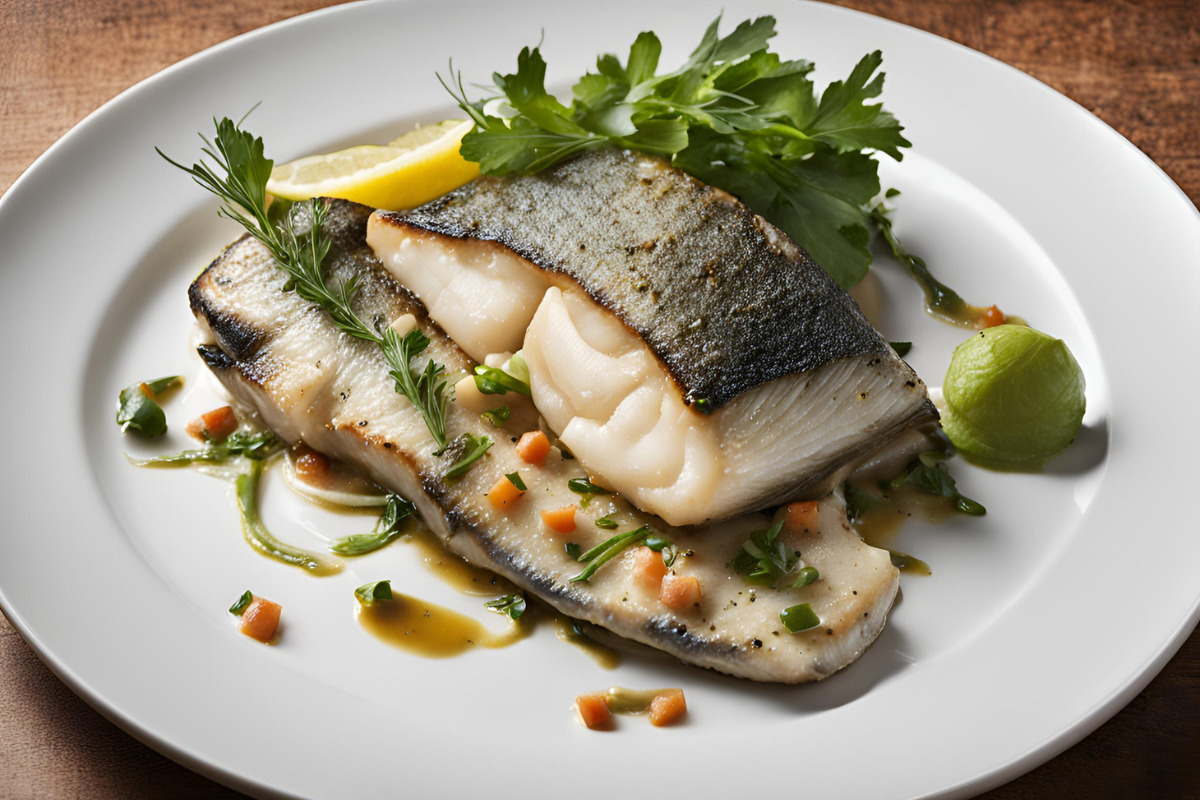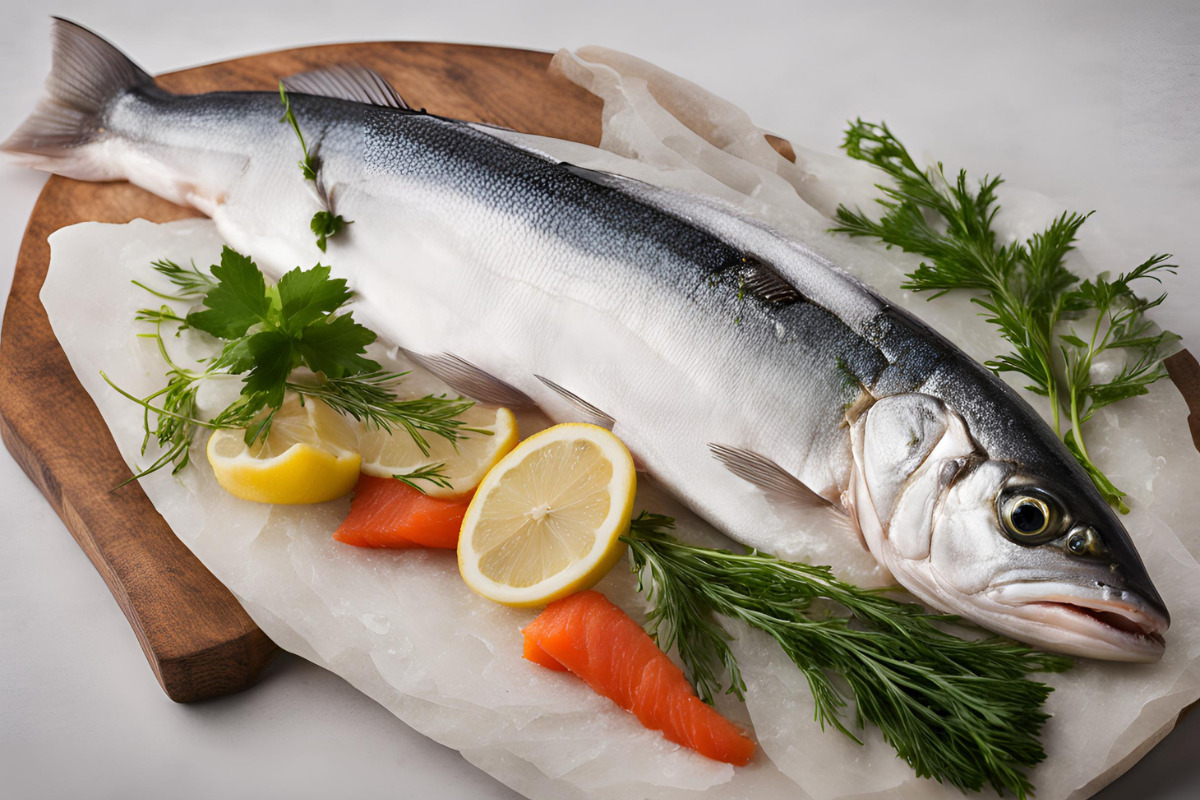Article’s Introduction
When you think about delicious, versatile fish, Branzino might come to mind. Known as the European sea bass, Branzino is a favorite among chefs and home cooks alike. Its delicate, white flesh and mild flavor make it a standout in various cuisines. This guide will explore everything you need to know about Branzino, from its natural habitat to its culinary uses and health benefits. Let’s dive in and discover what makes this Mediterranean sea bass so special.
Introduction to Branzino
Branzino, also called European sea bass, is a delightful fish prized in culinary circles. Originating from the Mediterranean and the eastern Atlantic, this fish has become a staple in many kitchens around the world. But what exactly makes Branzino so popular?
Its tender, flaky texture and mild, almost sweet flavor are two significant reasons. Moreover, it’s versatile in cooking, adapting well to various recipes and methods. Whether you’re grilling, baking, or steaming, Branzino always delivers a delectable dish.
Interestingly, Branzino is not just favored for its taste. It’s also packed with nutritional benefits, making it a healthy choice for many. Rich in protein, omega-3 fatty acids, and essential minerals, it supports a balanced diet. Additionally, its low-calorie content makes it ideal for those watching their weight.
In summary, Branzino is more than just a tasty fish. It’s a nutritious, versatile option that fits perfectly into a variety of dishes. As we move forward, we’ll delve deeper into its characteristics, culinary applications, and health benefits. This comprehensive guide aims to provide you with all the information you need about this remarkable fish. So, let’s explore further and uncover the secrets of Branzino.
What is Branzino?
Branzino, scientifically known as Dicentrarchus labrax, belongs to the Moronidae family. Often referred to as European sea bass, it’s found predominantly in the Mediterranean Sea and along the coasts of the eastern Atlantic Ocean. This fish boasts a sleek, silver body with a white, flaky flesh that’s both firm and tender.
One of Branzino’s defining features is its mild, sweet flavor, which makes it a versatile ingredient in the kitchen. Unlike some other fish, it doesn’t have a strong fishy taste, allowing it to pair well with various ingredients and cooking styles. Its skin, when cooked properly, becomes crispy and adds a delightful texture to the dish.
Branzino is also known by several other names, including loup de mer in French and spigola in Italian. These names often appear on restaurant menus, highlighting its international appeal. Despite these variations, the essence of Branzino remains the same—a flavorful, nutritious fish loved by many.
Branzino’s Habitat and Distribution
Branzino thrives in the coastal waters of Europe, particularly the Mediterranean and the eastern Atlantic. It prefers shallow waters, often found in estuaries and lagoons. These environments provide the perfect conditions for Branzino to flourish, with abundant food sources and suitable breeding grounds.
Interestingly, Branzino can adapt to both saltwater and brackish water, which is a mix of fresh and saltwater. This adaptability allows it to inhabit a wide range of coastal areas. Its ability to live in various water conditions contributes to its widespread distribution and availability.
The fish is typically caught in the wild, but there’s a growing trend towards aquaculture. Farmed Branzino ensures a steady supply throughout the year and helps reduce the pressure on wild populations. Sustainable farming practices are essential to maintaining the balance of marine ecosystems, ensuring that Branzino remains available for future generations.
Culinary Uses of Branzino
Culinary Importance
Branzino’s culinary appeal lies in its versatility and flavor. This fish is a favorite in many Mediterranean dishes and has made its way into global cuisine. Its mild taste allows chefs to get creative, using various herbs, spices, and cooking techniques to enhance its natural flavors.
Not only is Branzino delicious, but it’s also packed with nutritional benefits. It’s a rich source of protein, essential for muscle building and repair. The fish is also high in omega-3 fatty acids, which are known to support heart health and reduce inflammation. Moreover, it’s low in calories, making it a great choice for those looking to maintain a healthy diet.
Common Cooking Methods
One of the best things about Branzino is its adaptability to different cooking methods. Here are some popular ways to prepare this delightful fish:
- Roasting and Baking: Roasting brings out the natural flavors of Branzino. Simply season the fish with herbs, olive oil, and lemon, and bake it until the skin is crispy and the flesh is flaky.
- Grilling and Pan-Frying: Grilling Branzino gives it a smoky flavor that complements its mild taste. Pan-frying, on the other hand, creates a deliciously crispy skin while keeping the inside tender.
- Poaching and Steaming: These methods are perfect for preserving the delicate texture of Branzino. Poach it in a flavorful broth or steam it with aromatic herbs and vegetables for a light, healthy meal.

Popular Branzino Recipes
Branzino shines in various recipes, often featuring Mediterranean flavors. Here are some popular dishes:
- Mediterranean Style: This classic recipe involves stuffing the fish with fresh herbs like thyme and rosemary, along with slices of lemon and garlic. Roast it in the oven and serve with a side of vegetables.
- Asian-Inspired Recipes: For a twist, try Branzino with Asian flavors. Marinate the fish in soy sauce, ginger, and sesame oil, then grill or steam it to perfection.
- American Fusion Dishes: Combine Branzino with American culinary styles, such as a simple lemon-butter sauce or a spicy Cajun rub. These dishes highlight the fish’s versatility and ability to adapt to different cuisines.
Branzino vs. Other Fish
Comparison with Similar Fish
When comparing Branzino to other fish, it’s essential to note its unique characteristics. This section highlights how Branzino stands out among its peers, particularly against sea bass and striped bass.
Branzino vs. Sea Bass
While Branzino is often called European sea bass, it’s essential to understand the nuances. Sea bass is a broad term that includes various species, such as black sea bass found in the Atlantic waters of North America. Branzino, on the other hand, is specifically from the Mediterranean and eastern Atlantic regions.
- Flavor and Texture: Branzino has a milder, sweeter flavor compared to the stronger taste of other sea bass varieties. Its flesh is tender and flaky, making it ideal for delicate dishes.
- Culinary Use: Due to its subtle taste, Branzino is perfect for recipes that highlight fresh herbs and light seasoning, whereas other sea bass types might be better suited for more robust, spicy preparations.
Branzino vs. Striped Bass
Striped bass, another popular fish, is often confused with Branzino. However, they have distinct differences.
- Habitat: Striped bass is typically found along the Atlantic coast of North America, thriving in both saltwater and freshwater environments. In contrast, Branzino prefers the coastal waters of Europe.
- Texture and Flavor: Striped bass has a firmer texture and a slightly stronger flavor compared to the delicate, mild-tasting Branzino.
- Cooking Methods: While both fish can be grilled, roasted, or baked, Branzino’s milder taste makes it more versatile for lighter, Mediterranean-style dishes.
Buying and Storing Branzino
How to Buy Fresh Branzino
Selecting fresh Branzino is crucial for the best culinary experience. Here are some tips to ensure you’re getting the freshest fish available:
- Check the Eyes: Fresh Branzino should have clear, bright eyes. Cloudy or sunken eyes indicate that the fish is not fresh.
- Look at the Skin: The skin should be shiny and metallic, not dull. It should also be free of any brown spots or discoloration.
- Smell the Fish: Fresh Branzino should have a clean, sea-like smell. Avoid fish that have a strong, fishy odor.
When purchasing from a market, don’t hesitate to ask the fishmonger about the fish’s source and how long it’s been on display. This can provide insights into its freshness.
Storing and Handling Branzino
Proper storage and handling are key to maintaining the quality of Branzino. Here’s how to keep your fish fresh until you’re ready to cook:
- Refrigeration: Store Branzino in the coldest part of your refrigerator, ideally at a temperature between 32°F and 38°F. Keep it in its original packaging or wrap it in plastic wrap and place it on a bed of ice.
- Freezing: If you’re not planning to cook the fish within a couple of days, freezing is a good option. Wrap the fish tightly in plastic wrap, then in aluminum foil, and place it in the freezer. Properly stored, it can last up to three months.
- Thawing: When ready to use, thaw frozen Branzino in the refrigerator overnight. Thawing at room temperature should be avoided as this promotes the growth of microorganisms.
Sustainability and Farming
Sustainability is a critical factor when it comes to seafood. Understanding the impact of fishing practices on marine ecosystems is essential for making responsible choices.
Wild-Caught vs. Farm-Raised
- Wild-Caught Branzino: Fishing methods for wild-caught Branzino can impact marine habitats. Overfishing and bycatch are significant concerns. However, when sourced from sustainable fisheries, wild-caught Branzino can be a responsible choice.
- Farm-Raised Branzino: Aquaculture, or fish farming, has grown in popularity. When done responsibly, it can provide a steady supply without depleting wild populations. Look for certifications from organizations like the Aquaculture Stewardship Council (ASC) to ensure the fish is farmed sustainably.
Environmental Impact
The environmental impact of Branzino farming includes considerations such as water use, feed sources, and waste management. Sustainable practices aim to minimize these impacts, ensuring that aquaculture is both environmentally friendly and economically viable.
Branzino Farming Practices
Aquaculture techniques vary, but sustainable practices focus on reducing negative environmental effects while producing high-quality fish.
- Recirculating Aquaculture Systems (RAS): These systems recycle water within the farm, reducing the need for large amounts of fresh water and minimizing waste discharge.
- Integrated Multi-Trophic Aquaculture (IMTA): This practice combines the farming of multiple species, such as fish, shellfish, and seaweed, in a way that mimics natural ecosystems. It enhances resource efficiency and reduces environmental impact.
Supporting sustainable Branzino farming helps preserve marine ecosystems and ensures that this delicious fish remains available for future generations. For more on sustainable practices, visit the Monterey Bay Aquarium Seafood Watch.
Health Benefits of Branzino
Nutritional Profile
Branzino, known for its delicate flavor, also packs a powerful nutritional punch. This fish is not only delicious but also loaded with essential nutrients that promote overall health.
- Protein: Branzino is a fantastic source of lean protein, which is crucial for muscle growth and repair. A single serving provides a substantial portion of your daily protein needs without the added calories and fats found in red meats.
- Omega-3 Fatty Acids: These essential fats are known for their heart health benefits. Omega-3s help reduce inflammation, lower blood pressure, and decrease the risk of chronic diseases such as heart disease.
- Vitamins and Minerals: Branzino is rich in vitamins like B12 and D, which support energy production and bone health. It also contains important minerals such as selenium, zinc, and iodine, which play vital roles in thyroid function, immune health, and antioxidant defense.
Potential Health Risks
While Branzino is a nutritious choice, it’s essential to be aware of potential health risks associated with seafood consumption.
- Mercury and Contaminants: Like many fish, Branzino can contain trace amounts of mercury. However, it is generally considered low in mercury compared to larger, predatory fish. Pregnant women and young children should still consume it in moderation.
- Allergic Reactions: Fish allergies are relatively common and can cause severe reactions in some individuals. If you have a known seafood allergy, it’s best to avoid Branzino and consult with a healthcare professional.
FAQs about Branzino
Frequently Asked Questions
To wrap up, here are some common questions people have about Branzino:
What is the Difference Between Branzino and Sea Bass?
- Branzino, also known as European sea bass, is a specific type of sea bass found in the Mediterranean and eastern Atlantic. It is known for its mild, sweet flavor and delicate texture.
Is Branzino a Healthy Fish to Eat?
- Yes, Branzino is a healthy choice. It’s high in protein, omega-3 fatty acids, and essential vitamins and minerals, making it beneficial for heart health, muscle growth, and overall well-being.
How Do You Cook Branzino?
- Branzino can be cooked using various methods, including roasting, grilling, pan-frying, poaching, and steaming. Each method brings out its unique flavors and textures, making it a versatile ingredient in the kitchen.
Where Can I Buy Branzino?
- Branzino is available at many fish markets, supermarkets, and specialty stores. Look for fresh or sustainably farmed options to ensure the best quality.
Is Branzino Sustainable?
- Branzino can be both wild-caught and farmed. Sustainable farming practices help reduce the impact on wild populations and the environment. Look for certifications from organizations like the Aquaculture Stewardship Council to ensure sustainability.
For more information on the health benefits of fish, check out this article from Healthline.


